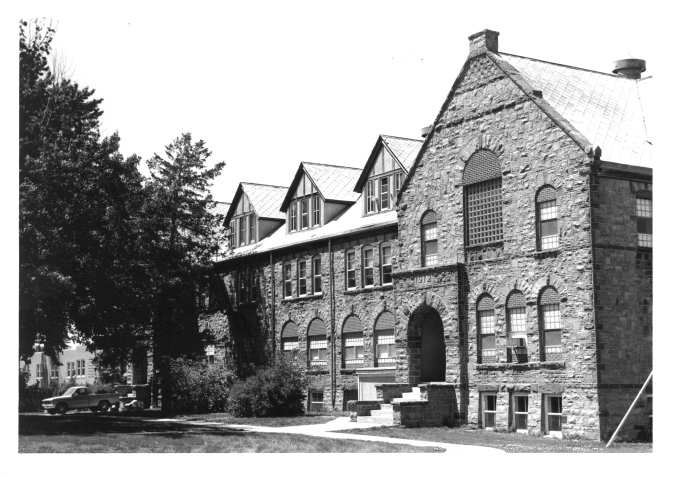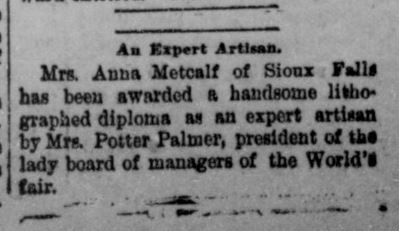On goes the saga of my research into the history of the women who were listed in the 1909 business directory for Sioux Falls. This is just preliminary research through online search engines and Ancestry.com, sources are cited in the text.
Miss Rose Lynch
Miss Lynch was listed in the 1909 business directory as the proprietor of the Cascade Rooming House. In the 1907 city directory, there is a Rose E. Linch who was proprietor of The Grand at 225 1/2 N. Main Ave [Sioux Falls City Directory (1907), 202]. Her husband Fred worked as a printer at Ross & Ross. Ella Rose Schlecht was born in Iowa in 1869 to parents who were of German heritage, and she married Fred Linch in 1898 [Twelfth U.S. Census, E.D. #319 (1900), 11]. She may have had a daughter previously with Nick Souvingier [Record for Mary Anna Souvingier, born 1887, Turner County, #733414, South Dakota Birth Records With Birth Dates Over 100 Years. South Dakota Department of Health, Pierre, South Dakota via Ancestry.com].
By 1908, Rose and Fred had divorced but both soon remarried [#10724, South Dakota Marriage Index, 1905-1914, 1950-2013 and South Dakota Marriage Certificates, 1905-1949. Pierre, SD, USA: South Dakota Department of Health via Ancestry.com]. In 1909, Rose married Howard Tanner from Chester, S.D. and they lived there, where Howard ran a saloon [#17528, South Dakota Marriage Index, 1905-1914, via Ancestry.com; Thirteenth U.S. Census, E.D. #265 (May 5, 1910), 10B]. Rose died in 1918 and was buried in Woodlawn Cemetery in Sioux Falls [“Rosa E. Tanner,” Find-a-Grave website; #1401841, Iowa, Deaths and Burials, 1850-1990. Salt Lake City, Utah: FamilySearch, 2013 via Ancestry.com].
Margaret Martin
Margaret Martin was listed in the 1909 business directory as a hairdresser. The census records vary widely on her date and place of birth, from 1874 to 1881 and between New York, South Dakota, and North Dakota [Fourteenth U.S. Census, ED #186 (1920), Sheet 5B; Fifteenth U.S. Census, ED #50-29 (1930), 3A; Sixteenth U.S. Census, ED #50-25B (1940), Sheet 14A]. Her gravestone in St. Michael’s Catholic Cemetery in Sioux Falls records her birth as 1874 and her death in 1948 [“Margaret Martin,” Find-a-Grave website].
In Sioux Falls early on, she worked on Main Avenue, in the Cascade Building, and in the Masonic Temple building [Sioux Falls City Directory (1898), 436, (1900), 205 and (1903), 289]. Then, for over forty years, she operated a beauty shop in the Minnehaha Building [Sioux Falls City Directory (1906), 146, (1911), 437, (1913), 466, (1928), 505, (1935), 194, (1940), 227, (1947), 636]. While she was the only hair dresser listed in the 1898 directory, there were fifty-two listings under “beauty shops” in 1939 [Sioux Falls City Directory (1900), 205 and (1939), 523].
In 1900, she lived with her mother “E.G.” and sister Mary (a manicurist) on Main Avenue [Twelfth U.S. Census, ED #260 (1900), Sheet 4]. For years, she lived in a house she owned at 708 S. Spring Avenue, for a time with her mother Ellen and then brother William, then took lodgings in larger houses on N. Summit Avenue [Sioux Falls City Directories; 1920 census; 1930 census].
Images of the old Minnehaha Block can be found in the online collections of the Siouxland Heritage Museums. One image from 1890 near the end of the building’s construction is linked here.
Miss Catherine McDonald
Miss McDonald was listed in the 1909 Sioux Falls business directory as running a restaurant. Catherine was born in Massachusetts in about 1865/1867 to parents from Vermont of Irish Protestant heritage [Thirteenth U.S. Census, ED #331 (April 18, 1910), sheet 3A; 1915 South Dakota census, sheet 694]. “Kate” E. McDonald came to South Dakota in about 1878 and initially worked as a domestic servant–in the 1880s, for hardware store owner, C.H. Vincent [Tenth U.S. Census, ED #20 (June 2, 1880), 10; 1915 state census; Sioux Falls City Directory (1888), 103, 165, (1889), 134]. At the turn of the century, Kate ran a boarding house on 123 1/2 S. Phillips Avenue [Sioux Falls City Directory (1898), 136, (1900), 114; Twelfth U.S. Census, ED #260 (June 2, 1900), sheet 3]. Later, Kate ran a boarding house at 328 1/2 S. Phillips (were KELO TV is now) and in the Van Eps Block at 118 1/2 N. Phillips Avenue (not extant) [Polk-Avery’s Sioux Falls City Directory (1903), 272, (1904), 162, (1909), 177, (1910), 308, (1911), 406; 1910 census]. The only record close to her name that I can find in the 1920 census doesn’t quite seem to fit, her occupation was listed as practical nurse and her birthplace Minnesota… [Fourteenth U.S. Census, ED #197 (January 3, 1920), sheet 1B]. She was still living at the time of the state census in 1925 and is listed in the city directory as “dom,” likely domestic servant at 1117 W. 9th Street [Sioux Falls City Directory (1925), 263].
Frances McKinley
Frances “Fannie” McKinley was listed in the 1909 business directory as principal of the South Dakota School for the Deaf. Frances was born in 1857 in Ohio to a father who was an Irish immigrant and a mother who had also been born in Ohio [Fourteenth U.S. Census, ED #200 (January 8, 1920), sheet 1A]. Her father was a physician/allopath from County Donegal [Family tree records on Ancestry.com]. Her family moved to Olathe, Kansas in about 1870 [1875 Kansas state census, p.26]. Before coming to Sioux Falls, she worked as a teacher at the Kansas Institute for the “Deaf and Dumb” in Olathe, Kansas (link to school history on their website, here) that had, not too long before, re-opened following the Civil War [1875 Kansas state census; Tenth U.S. Census, ED #99 (June 14, 1880), 33; Twelfth U.S. Census, ED #175 (June 1, 1900), 4].
Frances started in her position at the South Dakota school in 1908 and worked there until at least 1920 [Frank W. Booth, ed., The Association Review: The American Association to Promote the Teaching of Speech to the Deaf (Washington DC: Judd & Detweiler, 1908), 120; 1920 census]. In 1910, the school employed a matron and supervisors, five teachers, Frances as “head teacher,” a cook, baker, night watchman, engineer, laundress, and servants [Thirteenth U.S. Census, ED #338 (April 22, 1910), sheet 9A]. In 1920, the school employed seven resident female teachers as well as a matron, cook, nurse, supervisors, laundresses, servants, dairymen, watchman, and engineer, and there were about 71 students living on campus [1920 census]. In 1912, Frances received an honorary Master of Arts from Tarkio College in Missouri [The Olathe Mirror (KS), June 20, 1912]. Frances died in 1921 (in Oakland, California?), and was buried in Indpendence, Missouri [According to family trees on Ancestry.com; and “Frances McKinley” on Find-a-Grave website, link here].
The South Dakota School for the Deaf on E. 10th Street in Sioux Falls was first founded as school for “Deaf-Mutes” in 1880. In the early 1900s, enrollment rose and several new facilities were constructed in the 1910s, including a power plant and boys and girls dormitories [“South Dakota School for the Deaf,” National Register of Historic Places nomination, 1981, NRIS #81000576, SD SHPO #MH00001410]. The State Archives have an online record for a postcard of the Main Building at the school, link here. There is also a historic image of people (teachers/students?) sitting in front of a building at the School for the Deaf in the collections of the Siouxland Heritage Museums, online record is linked here. I wonder if she’s one of the women pictured…?
Mrs. Anna Metcalf
Mrs. Metcalf was listed in 1909 business directory as a dealer in “art goods.” Anna White was born in 1850 in Pennsylvania [Ninth U.S. Census, Whitewater, Winona County, Minnesota (August 4, 1870), 3; Twelfth U.S. Census, ED #260 (June 5, 1900), sheet 6]. Her father was born in Pennsylvania and her mother, New Jersey. She moved with her family to Minnesota as a child [Eighth U.S. Census, Rollingstone, Winona County, MN (June 9, 1860), 11]. In 1869, she married Civil War-veteran Edwin Metcalf and they farmed a homestead in Lincoln County, Minnesota for which they received patent in 1892 before soon after coming to South Dakota [“Minnesota Marriages, 1849–1950.” Index. FamilySearch, Salt Lake City, Utah, 2009, 2010 on Ancestry.com; 1870 census; Tenth U.S. Census, ED #137 (June 10, 1880), 9; 1885 MN State Census, Lake Benton, Lincoln County, MN, p.2; 1900 census].
In 1893, she had a work of needlepoint on display at the World’s Fair with a collection compiled by a Connecticut thread company and was honored by an official of the fair [Daily Plainsman (Huron, SD), August 8, 1894]. The notice appeared in several national papers, for example:
In the 1900 census, her occupation was given as needlework & embroidery and she lived with two of her grown children on W. 9th Street [1900 census]. She had an art embroidery shop/studio in the Hollister-Beveridge Block and then for many years in the Minnehaha Building [Sioux Falls City Directory (1900), 106, (1906), 149]. She continued her business until at least 1919 [Sioux Falls City Directory (1919), 312]. Anna died in February 1920 and was buried at Woodlawn Cemetery in Sioux Falls [“Anna Metcalf,” on Find-a-Grave website, link here].
During her time in Sioux Falls, her husband was most often living apart from his family in a home for disabled veterans. For some reason, she was recorded as a widow in the 1900 census and I can’t find her husband in that census for S.D. In 1907, Edwin was admitted as a patient at the State Soldier’s Home in Hot Springs, S.D., ill with rheumatism and weak lungs, and he worked a bit there as a carpenter [Thirteenth U.S. Census, ED #20 (April 15, 1910), sheet 1A]. Starting in 1918 (and perhaps earlier), he lived at the national military home in Sawtelle, California, until his death in 1923 [Fourteenth U.S. Census, ED #486 (March 23, 1920), 26B; Historical Register of National Homes for Disabled Volunteer Soldiers, 1866-1938; (NARA Microfilm Publication M1749, 282 rolls); Records of the Department of Veterans Affairs, Record Group 15; National Archives, Washington, D.C. via Ancestry.com].
The stories of these women continue to surprise me. One ran a major state institution for over a decade, and the record online in frustratingly sparse… Even when there isn’t much of a record, or a scrambled record, it’s interesting to think what kind of women they must have been to make a living, even when some of their lives were a bit adrift or uncertain.


